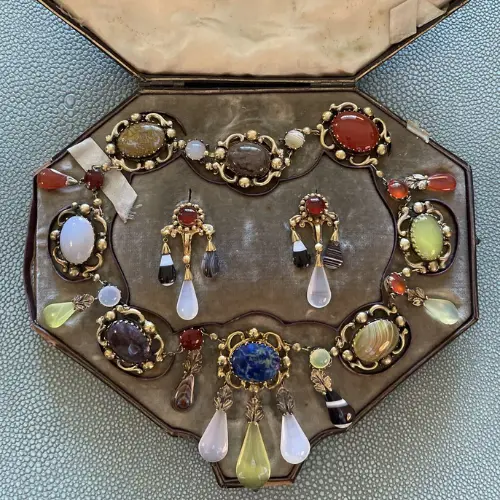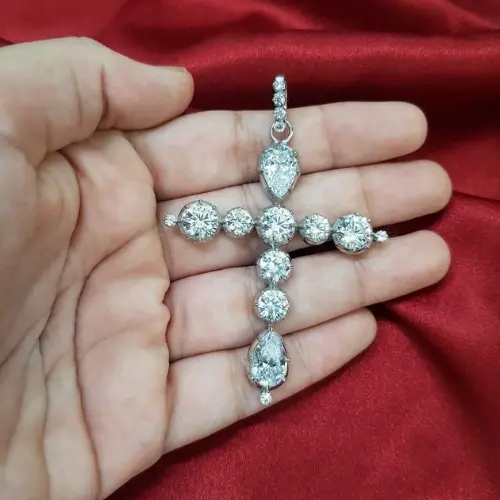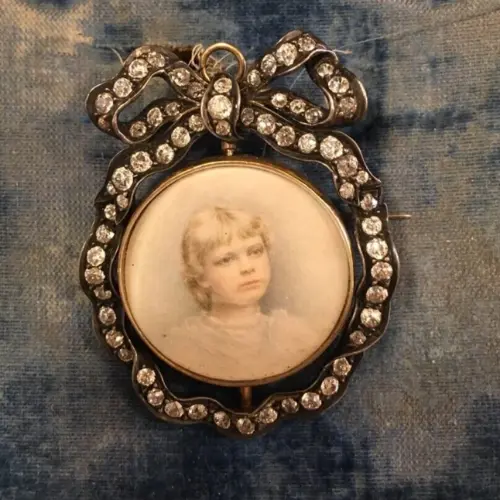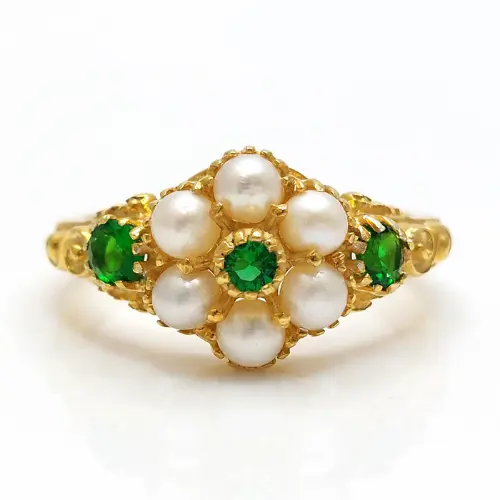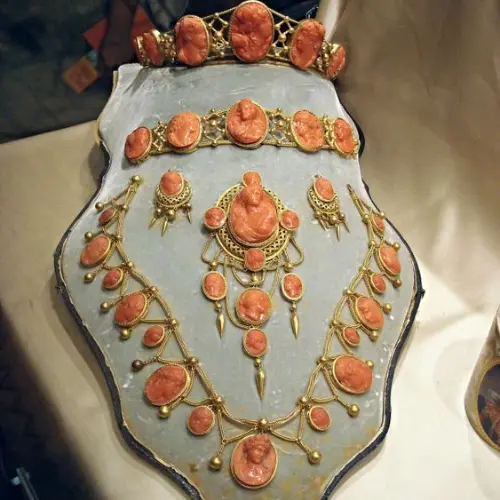In the early 19th century, the Regency Era marked a time of cultural and societal shifts in Britain, bringing with it a distinctive style that extended beyond fashion and permeated into the realm of jewelry. The Regency period, roughly spanning from 1811 to 1820, was characterised by elegance, refinement, and a departure from the opulence of the Georgian era. This blog delves into the captivating world of Regency Era jewelry, exploring its designs, materials, and the societal influences that shaped this era of sparkling elegance.
A Shift in Aesthetics
The Regency Era was a time of transition, both politically and culturally. With the Prince Regent, later known as George IV, assuming control due to the mental illness of his father, King George III, a new sensibility emerged. This era witnessed a departure from the elaborate and heavy jewelry styles of the Georgian era towards a more delicate and refined aesthetic.
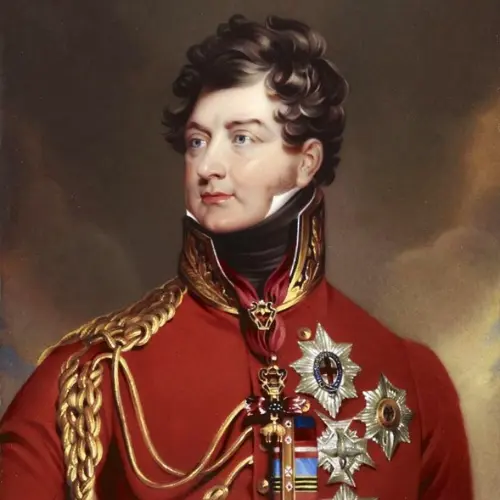
Design Elements
Regency Era jewelry was characterised by its simplicity, grace, and use of classical motifs inspired by ancient France, Greece and Rome. Intricate filigree work, delicate engravings, and fine detailing were favoured over ostentatious designs. Classical symbols such as laurel wreaths, cameos, and motifs inspired by mythology were commonly incorporated into jewelry pieces.
Gemstones and Materials
The gemstones used in Regency Era jewelry were chosen for their elegance and subtlety. Diamonds, pearls, and coloured gemstones like amethysts, topazes, and garnets were popular choices. The emphasis was on the natural beauty of the stones rather than their size, and they were often set in silver or gold.
Seed pearls, in particular, gained popularity during this period. These tiny pearls were used to create delicate strands in necklaces and bracelets, as well as to embellish intricate hair jewelry and tiaras. The soft, lustrous glow of pearls complemented the overall aesthetic of Regency jewelry, adding a touch of femininity and sophistication.
Cameos, often carved from shell or semi-precious stones, were another hallmark of Regency jewelry. These miniature works of art depicted classical scenes, portraits, or mythological figures and were highly prized for their craftsmanship.
Innovations in Jewelry Techniques
Advancements in jewelry-making techniques during the Regency Era allowed for the creation of intricate and delicate pieces. Cannetille work, a technique that involved twisting and coiling fine wires into decorative patterns, became popular. This technique allowed jewelers to create lightweight yet visually stunning pieces, such as filigree brooches and earrings.
Enamelling, another technique that gained prominence, involved fusing coloured glass onto metal surfaces to create vibrant and detailed designs. This allowed for a broader range of colours to be incorporated into jewelry, adding to the overall allure of Regency pieces.
The Influence of Historical Events
The Napoleonic Wars and the subsequent economic instability had a profound impact on fashion and jewelry during the Regency Era. The desire for simplicity and practicality in both clothing and accessories was a direct response to the somber economic climate and the need for frugality. As a result, jewelry became more understated, with a focus on craftsmanship and the use of smaller, more affordable gemstones.
Portraiture and Sentimental Jewelry
The Regency Era was marked by a fascination with portraiture, and this trend extended to jewelry. Miniature portraits were set into brooches, rings, and lockets, allowing individuals to carry sentimental keepsakes with them. These portraits often depicted loved ones or notable figures, and the jewelry served as a personal and cherished memento.
Hair jewelry, made from woven strands of human hair, also gained popularity during this time. Locks of hair were often incorporated into rings, bracelets, and necklaces as tokens of love and remembrance. These pieces held deep sentimental value, reflecting the emotional connections and relationships of the era.
Fashionable Accessories
Regency fashion was characterised by high-waisted dresses and empire silhouettes, and jewelry played a crucial role in completing the ensemble. Tiaras, combs, and hairpins adorned with pearls and gemstones were popular choices for enhancing hairstyles. Brooches, earrings, and necklaces were designed to complement the neckline and overall elegance of the attire.
The Influence of Romantic Literature
The Regency Era coincided with the Romantic literary movement, and the themes of love, nature, and emotion prevalent in literature were reflected in the jewelry of the time. Symbols such as hearts, flowers, and bows became popular motifs, representing the romantic ideals of the period. Sentimental jewelry, often exchanged between lovers, embraced these themes and added a layer of emotional depth to the pieces.
Legacy and Enduring Style
While the Regency Era lasted only a short time, its influence on jewelry design endured and continued to evolve in subsequent periods. The elegance, refinement, and sentimental qualities of Regency jewelry left an indelible mark on the world of adornment. Elements of Regency design can be seen in various jewelry styles throughout the 19th and 20th centuries, testifying to the enduring allure of this captivating era.
Evolution of Regency Design
The Regency Era marked a departure from the grandeur of Georgian jewelry, favouring delicacy and refinement. Today, elements of Regency design continue to influence modern jewelry, particularly in the resurgence of intricate filigree work and the use of classical motifs. Designers draw inspiration from the timeless elegance of Regency pieces, incorporating fine detailing and subtle symbolism into their creations.
Revival of Cameo Artistry
The art of cameo carving, a hallmark of Regency jewelry, has experienced a revival in contemporary design. Designers pay homage to the classical motifs and exquisite craftsmanship of Regency cameos, creating modern interpretations that blend tradition with a contemporary aesthetic. Cameo brooches and pendants featuring portraits, mythological figures, and intricate scenes continue to be cherished for their artistic merit and timeless appeal.
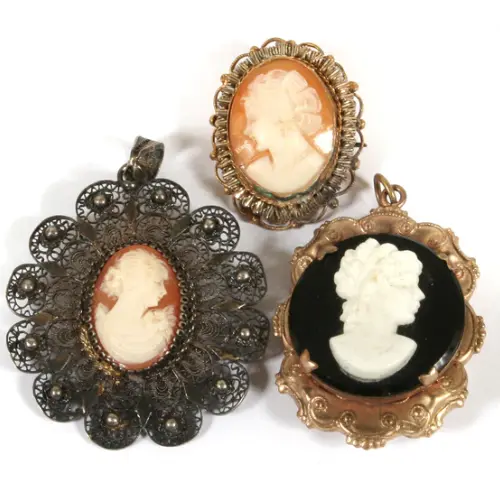
The Regency Era, with its political and cultural shifts, gave rise to a distinctive style in jewelry that remains timeless in its elegance and refinement. From delicate seed pearl necklaces to intricately carved cameos and sentimental hair jewelry, the pieces from this era tell a story of societal changes, economic challenges, and enduring romance. Regency jewelry serves not only as a reflection of the past but also as a source of inspiration for contemporary designs, reminding us of the enduring beauty and sophistication that transcends the boundaries of time.
